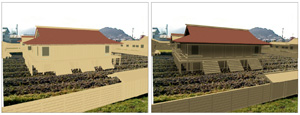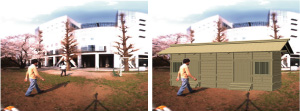Research - VR / MR
Fast Shadowing | Detection
Fast Shadowing of Virtual Objects Using Shadowing Planes in MR
 We have developed a fast shading and shadowing method that uses the shadowing planes and the basis images in mixed reality (MR). The method is model-based and computable in real time by using a standard graphics processing unit (GPU) making it particularly effective when used with an outdoor MR application. To express the shadows of objects, we map the shadow images that are synthesized from the basis images rendered offline with the basis lights onto the shadowing planes, and we compute alpha blending with the objects. The shadowing planes are generated from convex hulls of objects. We obtain the radiance parameters of the real scene from an omnidirectional image and compute the linear sum of the radiance parameters and the basis images on the GPU. We applied this shadowing method to both an indoor and outdoor MR application and found it to be effective.
We have developed a fast shading and shadowing method that uses the shadowing planes and the basis images in mixed reality (MR). The method is model-based and computable in real time by using a standard graphics processing unit (GPU) making it particularly effective when used with an outdoor MR application. To express the shadows of objects, we map the shadow images that are synthesized from the basis images rendered offline with the basis lights onto the shadowing planes, and we compute alpha blending with the objects. The shadowing planes are generated from convex hulls of objects. We obtain the radiance parameters of the real scene from an omnidirectional image and compute the linear sum of the radiance parameters and the basis images on the GPU. We applied this shadowing method to both an indoor and outdoor MR application and found it to be effective.
Publications:
- Tetsuya Kakuta, Takeshi Oishi, Katsushi Ikeuchi, "Real-time Soft Shadows in Mixed Reality using Shadowing Planes", Proc. IAPR Conference on Machine Vision Application (MVA2007), May. 2007, pp.195-198.
- Tetsuya Kakuta, Takeshi Oishi, Katsushi Ikeuchi, "Shading and Shadowing of Architecture in Mixed Reality", Proc. Int. Symp. on Mixed and Augmented Reality (ISMAR 2005), October, 2005.
- Tetsuya Kakuta, Takeshi Oishi, Katsushi Ikeuchi, "Virtual Kawaradera: Fast Shadow Texture for Augmented Reality", Proc. Int. Society on Virtual Systems and MultiMedia (VSMM 2004), Nov. 2004. pp.141-150.
Detection of Moving Objects and Cast Shadows Using Spherical Vision Camera for Outdoor Mixed Reality
 This paper presents a method solving the occlusion problem in Mixed Reality (MR). We cut out foreground from a real image using probability-based segmentation method. Using the color, spatial and temporal priors, we can improve the accuracy of the segmentation. The energy minimization is executed by graph cuts. Then we remove shadow region from the foreground with log F value calculated from the pixel value and the spectral sensitivity characteristic of the camera. Finally we superimpose virtual objects using the stencil buffer which is used to limit the area of rendering for each pixel. Synthesized images of an outdoor scene show the efficiency of the proposed method.
This paper presents a method solving the occlusion problem in Mixed Reality (MR). We cut out foreground from a real image using probability-based segmentation method. Using the color, spatial and temporal priors, we can improve the accuracy of the segmentation. The energy minimization is executed by graph cuts. Then we remove shadow region from the foreground with log F value calculated from the pixel value and the spectral sensitivity characteristic of the camera. Finally we superimpose virtual objects using the stencil buffer which is used to limit the area of rendering for each pixel. Synthesized images of an outdoor scene show the efficiency of the proposed method.
Publications:
- L. B. Vinh, T. Kakuta, R. Kawakami, T. Oishi, and K. Ikeuchi, "Detection of Moving Objects and Cast Shadows Using Omni-directional Camera for Outdoor Mixed Reality '' CVIM 08, Kyoto, 2008. (in Japanese)


